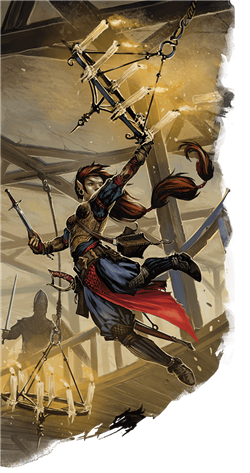WARNING: Everything in this article is homebrew, and you should ask your Dungeon Master before trying to use it in your home game. None of this is legal for use in the D&D Adventurer’s League.
In Rogue 101: A Beginner's Guide to Stealth and Subterfuge, I created a simple combat trick to make life more exciting and swashbuckling for rogues.
House Rule: Combat Stunt
As an action (or in place of a single attack if you can attack multiple times when you take the Attack action), you can make a DC 15 ability check. You must propose which ability and skill proficiency you use to make this check to the DM before you make it, and can only perform this check with the DM’s approval.
If you succeed on this check, you can make a single weapon attack or a Dexterity (Stealth) check with advantage. If you fail this check, you waste your action. For instance, while in the jungle, you can make a Dexterity (Acrobatics) check to swing from a vine and attack a creature on the other end of a chasm. In the desert, you could make a Strength (Athletics) check to kick up a cloud of sand and duck behind cover as the enemy blinks sand out of its eyes. Or, while in an echoey cave, you could make a Charisma (Deception) check to throw your voice and convince an enemy that you are approaching to attack it from a different direction.
 This stunt is a simple catch-all mechanic for any sort of combat trick that a rogue might want to take in combat to gain a slight edge before hiding or making an attack. It allows you to (possibly) gain advantage for being stylish and making combat more varied and lively than “I move. I attack. Do I have sneak attack?”
This stunt is a simple catch-all mechanic for any sort of combat trick that a rogue might want to take in combat to gain a slight edge before hiding or making an attack. It allows you to (possibly) gain advantage for being stylish and making combat more varied and lively than “I move. I attack. Do I have sneak attack?”
You can use this combat trick no matter your character’s class, but be aware that you waste your action if you fail your skill check. Rogues are the class best suited to using this trick for a number of reasons. They only have one attack per turn, and want to maximize the odds of this attack dealing damage. Gaining advantage on an attack is incredibly powerful, since it also activates their Sneak Attack feature. Rogues also have lots of skill proficiencies and the Expertise feature, making it much more likely that they’ll succeed on the DC 15 ability check required to use this generic combat stunt.
Unique Combat Stunts
The design intent behind the generic combat stunt presented above was to create a simple framework that players and Dungeon Masters could use to improvise their own stunts. However, it can be difficult to think of creative and cinematic action moves on demand, especially if you want to do more with your maneuver than just gain advantage on an attack roll. Here are eight new tricks that your character than use to fool, confuse, and outmaneuver your enemies.
These tricks can be used by characters of any class, but are most useful for characters that would describe themselves as “swashbucklers,” “action heroes,” “daredevils,” or “dashing scoundrels.” As with the generic combat stunt presented above, these unique stunts are most useful for rogues, but low-level bards, fighters, and monks may also get some mileage out of them.
Stunt Saving Throw
If a combat stunt requires another creature to make a saving throw, the DC of that saving throw is equal to 8 + your Strength or Dexterity modifier (your choice) + your proficiency bonus.
Climb Foe
 You clamber onto a massive creature in order to hide in its blind spot.
You clamber onto a massive creature in order to hide in its blind spot.
The creature you want to climb must be at least one size larger than you and must be within your reach. Using at least one free hand, you try to grab the creature as an action. Make a Strength (Athletics) or Dexterity (Acrobatics) check (your choice) contested by the target’s Strength (Athletics) or Dexterity (Acrobatics) check (its choice). If you succeed, you climb onto the creature and hang on.
While hanging onto a creature, it can’t see you (unless you are hanging onto the front of the creature or it can also see behind it), and it makes attacks against you with disadvantage. If the creature moves, you can choose to let go as a reaction and fall to the ground beneath it, otherwise you move with it. At the end of each of your turns, you must make a DC 10 Strength saving throw or lose your grip and fall off.
Dazzling Flourish
You swing your blade in a dazzling pattern, causing your target to look in all directions—except the one your attack is actually coming from.
Choose a creature you can see within 5 feet of you. Make a Charisma (Deception) check contested by that creatures Wisdom (Insight) check as you swipe your blade in all directions. If you succeed on this contest, you make a single melee weapon attack with advantage.
Ensnaring Lasso
You hastily tie a lasso or attach a grappling hook to your rope and hurl it at a creature’s legs.
If you are holding a rope, you quickly tie a noose or prepare a grappling hook and make a ranged weapon attack to throw it at a creature you can see within 30 feet as an action. On a hit, the creature must make a Strength (Athletics) or Dexterity (Acrobatics) check (its choice) opposed by your Strength (Athletics) check. If it fails, you choose whether it falls prone or is pulled up to 10 feet toward you.
You can cause a snared creature to fall prone or be pulled up to 10 feet toward you as an action. The snared creature can use its action to make a DC 10 Dexterity check, escaping the snare on a success. Severing the rope also frees the creature.
Evasive Roll
You dive and tumble in an attempt to avoid an attack.
You make a DC 15 Dexterity (Acrobatics) check as a reaction when you are attacked by a creature within 5 feet of you. If you succeed on this check, you move 5 feet in a direction of your choice. If this causes you to leave the creature’s reach, the attack misses and it cannot make an opportunity attack against you. If you are still in the creature’s reach, it makes the attack that triggered this reaction with disadvantage.
If you fail this check, the attack that triggered this reaction automatically hits.
Pendulum Strike
 You swing from a vine, rope, or chandelier to strike a foe with staggering force.
You swing from a vine, rope, or chandelier to strike a foe with staggering force.
You grab a hanging rope or similar tether and make a DC 15 Dexterity (Acrobatics) check as an action to swing towards a creature. On a success, you can make a single melee weapon attack with advantage against that creature as part of the same action. If your attack deals bludgeoning damage, the creature must also make a successful Strength saving throw or be pushed 10 feet away from you.
Ricochet Shot
Your trick-shooting skills allow you shoot past your target, ricochet your shot off a nearby surface, and strike your target from behind.
Make a DC 15 Wisdom (Perception) check to line up a trick shot at a creature or object within range of a ranged weapon you’re wielding. There must be a solid surface within 30 feet of your target to ricochet your shot off of. On a success, you make a single ranged weapon attack with advantage. On a failure, you make a single ranged weapon attack but it automatically misses.
Is it Possible to Ricochet an Arrow?
While bullets, slingstones, and other round missiles can be ricocheted by a skilled shooter, it is nearly impossible to ricochet an arrow or a crossbow bolt and cause it to hit another target with any degree of precision. Talk with your DM before using this stunt; they might allow it if your character is a literal demigod or if you like to play following the “rule of cool” instead of following the laws of physics.
Sandscreen
By hurling a handful of sand, glass shards, or embers at your foe, you blind them long enough for you to make a quick getaway.
You hurl sharp or stinging particles at a creature you can see within 5 feet of you as an action. This cloud of sharp objects could be from your inventory, such as a bag filled with glass shards, or from the environment, such as kicking up a cloud of sand from the desert dune around you. That creature must make a successful Constitution saving throw or be blinded until the end of your turn.
Underbelly Slide
You skid between a creature’s legs to strike at it from below.
Make a DC 15 Dexterity (Acrobatics) check to slide underneath a creature that is your size or one size larger than you. You have advantage on this check if you moved 15 feet straight toward the creature before making this check. On a success, you can move through the creature’s space and make a single melee weapon attack against the creature with advantage as part of this action. On a failure, you can move through the creature’s space, but fall prone after moving through its space.
I Know Your Tricks!
Dungeon Masters should implement these stunts in a way that best suits their players. As mentioned in Rogue 101, "The best stunts are used once and thrown away. From an in-universe standpoint, using an improvised attack as a standard tactic defeats the purpose of using the situation at hand to your advantage." If your players are using the same trick over and over again (and this overuse is making the game less fun or interesting for you or your players), consider implementing the following rule:
I Know Your Tricks
Once you use a combat stunt, you can't use it against the same creature until you complete a long rest. Additionally, if you use a stunt against a creature that saw you use the same stunt in the past hour, you have disadvantage on ability checks to perform that stunt against it and it has advantage on saving throws made to resist that stunt.
It’s Your Turn!
These eight tricks are hardly the be-all and end-all of combat tricks. They may suit your playstyle, or they may not fit your version of D&D at all. Not every Dungeon Master will approve of every improvised action; the same goes for these combat stunts. Whether or not these stunts spoke to you, I that they’ve inspired you to invent your own! I’d love for you to post your own creations posted in the comments; I’ll look at every single one of the comments to see all your cool and inventive dirty tricks.
 James Haeck is the lead writer for D&D Beyond, the co-author of the Critical Role Tal'Dorei Campaign Setting, and a freelance writer for Wizards of the Coast, the D&D Adventurers League, and Kobold Press. He lives in Seattle, Washington with his fuzzy acrobats, Mei and Marzipan. You can usually find him wasting time on Twitter at @jamesjhaeck.
James Haeck is the lead writer for D&D Beyond, the co-author of the Critical Role Tal'Dorei Campaign Setting, and a freelance writer for Wizards of the Coast, the D&D Adventurers League, and Kobold Press. He lives in Seattle, Washington with his fuzzy acrobats, Mei and Marzipan. You can usually find him wasting time on Twitter at @jamesjhaeck.








-
View User Profile
-
Send Message
Posted Apr 16, 2018These are awesome! I do disagree a little with the Lasso throw: perhaps a full action or bonus action to tie the knot, certainly not a free action included in the act. Should need to be pretied or cost time to do so. Otherwise it cuts into spells like thornwhip and lightning lure too much, part of the advantages of magic is it does these things instantly and for some damage.
-
View User Profile
-
Send Message
Posted Apr 16, 2018I played a monk who would take a ready action every turn while fighting a rival monk. My action was to watch the villain and punch their fist as they attempted to punch me. To manage it I needed a DEX save to see if I manages to follow the attack and then STR vs. STR for who would be damaged. I ended up breaking on e of their hands and they mine before the fight was over. I think the DM was being generous since he liked my creativity.
-
View User Profile
-
Send Message
Posted Apr 16, 2018(Edit: And I just noticed the author(s) involved. Clever me! I guess this is just 'free' advertisement... heh.)
I'm a fan of Kobold Press, and use a lot of their supplements in the games I run. One nice one is called Beyond Damage Dice, and gives a lot of similar specialty attacks and non-attack actions you can take with your weapons. Stuff like
There are a couple of options each for many different weapons, like swords, pickaxes, daggers, etc etc etc. I recommend it
-
View User Profile
-
Send Message
Posted Apr 16, 2018Great and useful piece. I'll grab that BEYOND DAMAGE DICE, too.
-
View User Profile
-
Send Message
Posted Apr 16, 2018You can ricochet an arrow or crossbow bolt as long as the angle of reflection is low. Which means in order to get it to go 180 degrees would require a series of precisely angled walls. Also, by the time it got to the end it would not have enough momentum left to cause any damage. So impractical, but possible.
-
View User Profile
-
Send Message
Posted Apr 16, 2018Ooh! I'd love to see an official subclass with tricks like this built in! It'd be like the rogue of the Battlemaster Fighter: any rogue could still try these things, just like any fighter can try to disarm an opponent at the DMs option, but they can just do it as part of a class feature.
-
View User Profile
-
Send Message
Posted Apr 16, 2018LOL @ "the rule of cool." In games I DM I usually remind my players that I practice "the realism of action movies" instead of actual realistic assessments. After all we can play Dragonborn, or can throw Magic Missiles.
I might get into these, but the rogues in the party will minimax one proficiency stat and attempt to use the same maneuver every damn round to score that sweet sneak attack damage. Maybe once per encounter.
-
View User Profile
-
Send Message
Posted Apr 16, 2018Hello,
I just want to say that You are making a great job here. I really like your Articles. Please, vam You write begginers guide to Paladin od bard?
-
View User Profile
-
Send Message
Posted Apr 16, 2018-
View User Profile
-
Send Message
Posted Apr 16, 2018In any D&D games, AL included, I've witnessed scores of such examples of ability/skill checks to accomplish similar results. The DM sets the appropriate ability/skill DC and allows the player to attempt it or fail and waste their action. So, while "named stunts" aren't technically legal, such tactics are being used routinely in games under the DM's purview, using the guidelines typical of the DM's guide. The DM always handles the odds and ends of game situations as they come up.
-
View User Profile
-
Send Message
Posted Apr 16, 2018Underbelly Slide. Um, Yes! Makes me think of that scene from the Warcraft movie.
For beefier characters (or desperate ones) how about a plain old "Tackle"? :-D That was a homebrew one that always made sense to me, since it happens in real life so often and new players think of it on their own. Basically it would allow a character to grapple and prone a foe in one shot, but with a price tag. If you don't make the DC you miss the tackle and are the one who ends up prone now at the feet of your foe. Useful maybe at lower levels, but not as much once you have that extra attack.
By the way, I really like your articles! Keep them coming!
-
View User Profile
-
Send Message
Posted Apr 16, 2018-
View User Profile
-
Send Message
Posted Apr 17, 2018Excellent article and options!
I appreciate the "I Know Your Tricks" limitation. It makes in-game sense, it imposes a harsh and realistic restriction, while not making it impossible to do the same trick twice.
-
View User Profile
-
Send Message
Posted Apr 17, 2018I loooove this is super fun, is something i actually do from time to time and having it in a rule would be cool, the only thing im worried is that it makes DEX even more of a great stat that it already is
-
View User Profile
-
Send Message
Posted Apr 17, 2018I love these kind of stunts, reminiscent of the Battle Master's maneuvers. If a DM wants to make these kind of stunts available but not necessarily to all characters (both to make them "special" and not to bog the game down) is to create a feat that "unlocks" some of them, like the Martial Adept feat does for Battle Master maneuvers. I did that for the variant DMG actions Flank, Mark, and Disarm. I slightly modified some of the mechanics and created the feat Tactical Expert for my group, which unlocks these special actions for the character that takes the feat.
Another idea is to use Hero Dice. Each character gets one Hero Die at the start of each session, which is a d6 (like DMG variant rule suggests). Player can use that Hero Die once during *that* session to perform one heroic stunt (from a list of stunts pre-determined by the DM, like those in this article for example). Player can add the result of the die to the ability check (or other required stunt roll).
One stunt I've added to our game is the Blood Choke, as performed by Wesley on the Giant in The Princess Bride.
-
View User Profile
-
Send Message
Posted Apr 17, 2018I already allow a number of these (the mechanics may be a little different) for any character who wants to use them, not just rogues. Of course I fall into the camp of the rules are only suggestions and anyone can attempt anything (even the impossible) and the DM determines how likely it is to succeed and implements the mechanics to make it happen.
I guess my biggest objection is I already see some of this as a "Sneak Attack." So much so that when I explain the difference between earlier editions "back stabs" and the current "sneak attack" I tell my players to ignore the name "sneak attack" and instead refer to it as "Fighting Dirty."
Those objections aside, I like the article and see it as inspiration for DM's and players alike.
-
View User Profile
-
Send Message
Posted Apr 17, 2018An ability like Dazzling Flourish would be the optimal action for my Bard each and every round. A single level dip into Rogue (hypothetically) and he’s now a self-sustaining Sneak Attack Machine.
I know the author placed an optional “once per long rest” cap option in these tricks, but that seems inelegant. If you’re the type to swing from a chandelier or kick sand, you’re likely going to try it more than once per day.
As a DM, I’d probably change these give smaller bonuses. I could see something like Dazzling Flourish granting an additional +2 to hit rather than advantage, removing the once per long rest restriction. Failure would mean you still get to attack normally, but your enemy sees through your ruse, granting them the +2 to hit you instead. Yes, this means more bookkeeping, and could slow down combat, so it’s not perfect.
If you really like the ability to gain larger bonuses like advantage, I’d suggest making them new Maneuvers available to the Battle Master Fighter or to anyone who takes the Martial Adept feat.
You could also turn each trick into its own feat. Look at another existing feat for a comparison:
Defensive Duelist
Prerequisite: Dexterity 13 or higher
“When you are wielding a finesse weapon with which you are proficient and another creature hits you with a melee attack, you can use your reaction to add your proficiency bonus to your AC for that attack, potentially causing the attack to miss you.”
You have to spend a feat/ability score improvement just to learn it, and then taking the action functions like a minor Shield spell that scales. And even after you learn it, you still have to spend your reaction that round to pull it off. Spending your reaction or bonus action seems like another good resource cost to fuel these tricks as they’re written, without needing a once per long rest cap.
Finally, I could see these as being ways to flavor the Help Action to give *another* player advantage. In this scenario, my Bard uses Dazzling Flourish to distract a foe, giving our Barbarian advantage on her next attack.
As DM, it’s your call how to implement them in your games. These are just my initial thoughts and feedback. The author is definitely helping to cover one of D&D’s flaws, that being combat by default can feel very binary. I hit or I miss. If this system used the FFG dice, tricks like these could be worked into the narrative dice very easily.
-
View User Profile
-
Send Message
Posted Apr 17, 2018These are awesome James, thank you!!!
-
View User Profile
-
Send Message
Posted Apr 17, 2018I have been trying to create a homebrew monster called the Kobold Warlord but when i press save changes and exit out of the monster building screen it does not save. I was wondering if it was something I was doing wrong or if its a bug.